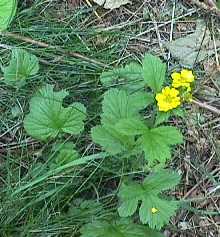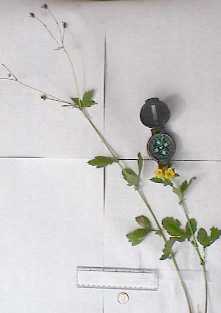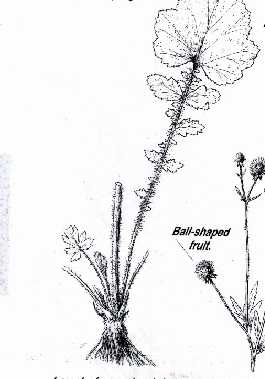


General Species Description
- Largeleaf avens is a perennial herb. It has one to several flowering stems. It grows from 30-100 cm tall. It has light green leaves borne at the base and along the flowering stem.
Leaves
- The basal leaves are pinnately compound, round or heart-shaped leaflets to 30 cm long, with heart shaped terminal leaflets and many small irregular leaflets above the base. The leaves on the hairy flowering stems, are three-lobed, alternate near the base and opposite near the top.
Inflorescence/Flowers
- The flowers have five parts, are dull yellow, with broad petals to 6 mm long. Pistils and stamens are numerous. S.S. Cooke does not mention blooming period, however I have noted that it blooms through August.
Fruits
- The fruits are ball-shaped with numerous, hook-tipped seeds.
Habitat
- Largeleaf avens grows in emergent and forested wetlands, frequently in clear, disturbed sites of deciduous woods and clearings. It tolerates mineral soils. Occurs in meadows and along stream banks as well as moist upland sites, and tolerates fluctuating water levels.
Range
- It is found from Alaska to Baja California and throughout the Northwest from sea level to sub alpine levels. Two N.W. varieties are found, one east of, and one west of the Cascades.
Similar Species
- Largeleaf avens is sometimes confused with Ranunclus spp. and silver weed (Potentilla anserina) which have 5-petalled, yellow flowers. Buttercups have shiny petals and different shaped, darker green leaves; ranunculus seeds are lacking hooks.
Ecological Value
- No reports of animals using seeds. The plant is asthetically pleasing and is used by gardeners.
Human Value
- Native peoples of the Northwest used the roots for flavoring stews. The roots brewed as tea were used for aleviating stomach pains and rheumatism. Leaves were used for poutives for reliving boils. It was also reportedly used for female-related problems. Related species( G. ciliatum) species are also noted for making teas.
References
- Cooke, S.S., Ed. 1997. A Field Guide to the Common Wetland Plants of Western Washington & Northwest Oregon. Seattle Audubon Society and Washington Native Plant Society. Seattle, WA, 417 pp.
Hitchcock, C.L. and A. Cronquist. 1973. Flora of the Pacific Northwest. University of Washington Press. Seattle, WA, 703 pp.
Kozloff, E. N. 1991. Plants and Animals of the Pacific Northwest. University of Washington Press. Seattle, WA, 264 pp. .
This page was created by: Pete Catching, August 2000
Return to Northwest Oregon Wetland Plants Project